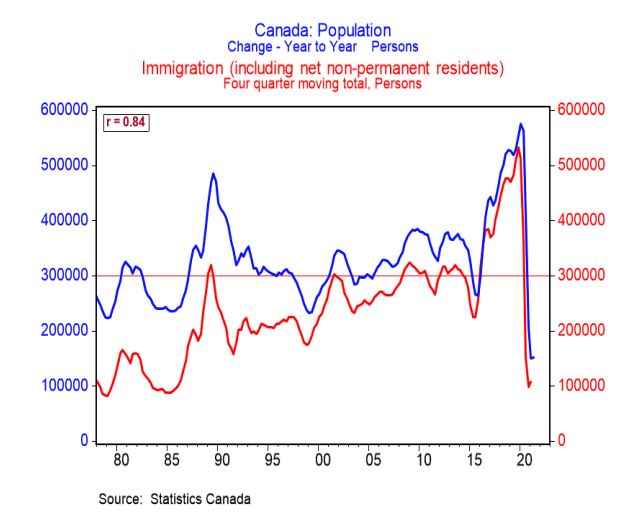Canada’s immigration heavy population growth plummeted during the pandemic. BMO Chief Economist Douglas Porter is starting to see population growth finally stabilize. However, it’s at a much lower level than the country saw pre-pandemic. While the most recent quarter shows near-normal growth, a lot of ground needs to be made up. If it isn’t made up quickly, it can be problematic for economic growth and home prices.
Canadian Population Growth Found A Bottom?
Canadian population growth has plummeted, but is finally showing some signs of stabilizing. The population increased 0.2 percent in the second quarter of 2021, rising to 38.1 million people. Porter said this is close to typical for the quarter, but the annual growth is very much lagging.
The annual rate of population growth was just 0.4 percent, or roughly 150,000 people. Not even close to the annual growth seen the year before, which came in at 1.5 percent, about 575,000 people. That’s a drop of just under three-quarters, which is huge.
Falling Immigration Slowed Population Growth
Canada’s robust population growth has been mostly immigration recently. It’s a plan that doesn’t work all that well in a pandemic, as we have just seen. “Not surprisingly, the slowdown was mostly driven by a near-50% plunge in the number of immigrants, and an outright decline in non-permanent residents,” said Porter.
The drop in immigration made the country largely dependent on the birth rate, which isn’t very high. Though the most recent quarter did see an uptick in international students. It just wasn’t enough to make up for the past year.
Housing Usually Cools In These Circumstances
Even with population growth rising towards normal levels, the country is playing catch-up. “From an economic perspective, the stark cooling in population would normally chill housing demand, but clearly other forces took over. As well, consumer spending and job markets have been overwhelmed by greater forces,” he said.
“However, if inflows remain subdued for long, underlying demand will cool (for housing and goods), while labor supply will be constrained. Bears watching.”
Like this post? Like us on Facebook for the next one in your feed.


If it isn’t made up quickly, it can be problematic for economic growth and home prices.
Well no. That’s the narrative the banks and government have been pushing because they are keen to keep propping up the housing market. Population growth helps GDP, not GDP per capita, which is the important measure if you’re trying to determine whether we’re becoming better off or not. This has been covered right here on BD.
Since 2008, real gdp per capita is in the negative for every western nation except America, Ireland and Switzerland.
Hmmm, slow growth means overall population is still increasing.
I believe once the lock down is lifted there will be a surge because wealthy immigrants are looking for a safer place.
Infact this sudden surge might actually be larger than anyone expects especially when suppliers are basing their supply decision using current immigration numbers. For example this deceiving number might convince some suppliers to cut back, but infact once things open up a surge will come.
This is highly unpredictable in the short term, but long term we know population growth will happen.
Being wealthy in a developing country brings more clout and rights than living in Canada. Why would a wealthy businessman from an emerging economy flee his homeland to live like a second class citizen in Canada?
And YET they say it’s a supply issue. All of a sudden, during the pandemic, there is a shortage of supply. NOT… More like economic policies
Way too early to talk about this.
Doesn’t a Ponzi scheme rely on growth to expand?
Firstly, the population isn’t 38 million but around 40 million when including students, new residents, refugees and other arrivals. Second, the worker shortage problem like in the US is completely phoney. Most people don’t want to work at a crappy gig retail/service sector job. You’ll find that any job that isn’t demeaning has thousands of applicants ready and waiting to get that $40k+ job. The problem is that Canada has a shortage of real jobs and the majority of the depressed service sector workers (nee millennials) would rather stay at home and get their gov dole than go back to working in a drudgery working environment where you have to interact with the scum of the earth.
Population estimates include students, residents, and refugees. It literally says immigration is a part of the country, which includes temporary residents.
So your narrative is 2 million people are hiding from the government in big cities.
You are wrong . In the US now – banks, pharmacies, IT sector , school, hospitals have big shortage of staff for jobs 50 K plus with all benefits.
Welcome to the great Canadian rat race!